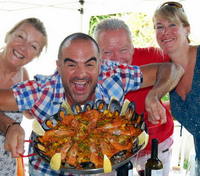|
Conversion Tables - For Cooks
Temperatures,
Weights and Measures
Use these easy conversion
tables to
get it right in your kitchen wherever you may be.
Or you can enter the the temperature you want to convert in the
calculator below.
Enter the numbers in the top left hand box and choose your scale i.e.
ºF or ºC. Easy and fairly accurate, although not exact.
Pam is grateful to Wikipedia for the charts below.
Temperature Converter supplied by Unitconversion.org
The values in these conversion tables are only
approximate and have been rounded up or down for clarity.
Always stick to either metric or imperial measurements in the same
recipe.
Oven
Temperatures Conversion Tables
Oven temperatures can be in degrees Celsius (International) --
previously Centigrade, degrees Fahrenheit (in the USA) or by gas mark
(UK). This table provides a rough guide to conversion between the
ranges.
For fan
assisted ovens use a setting of 25° Celsius (77° Fahrenheit)
less than the recipe calls for. Cooking times can probably be reduced
by 10 minutes for every hour of cooking time.
| Centigrade
|
Farenheit
|
Gas Mark
|
Verbal
|
| 100° (107°) |
225° |
¼ |
Very slow/Very low
|
| 120° (121°) |
250° |
½ |
Very slow/Very low
|
| 140° (135°) |
275° |
1 |
Slow/Low
|
| 150° (149°) |
300° |
2 |
Slow/Low
|
| 160° (163°) |
325° |
3 |
Moderately slow/Warm
|
| 180° (177°) |
350° |
4 |
Moderate/Medium
|
| 190° (191°) |
375° |
5 |
Moderate/Moderately hot
|
| 200° (204°) |
400° |
6 |
Moderately hot
|
| 220° (218°) |
425° |
7 |
Hot
|
| 230° (232°) |
450° |
8 |
Hot/Very hot
|
| 250° (246°) |
475° |
9 |
Very hot
|
| 260° |
500° |
10 |
Extremely hot
|
Weights
| Imperial
|
Metric
|
|
Imperial
|
Metric
|
| ¼ oz |
5 g |
|
7½ |
210 g
|
| ½ oz |
10 g |
|
8 oz |
225 g
|
| ¾ oz |
20 g |
|
8½ oz |
235 g
|
| 1 oz |
25 g |
|
9 oz |
250 g
|
| 1 ½ oz |
40 g |
|
9½ oz |
260 g
|
| 2 oz |
50 g |
|
10 oz |
275 g
|
| 2½ |
60 g |
|
10½ oz |
285 g
|
| 3 oz |
75g |
|
11 oz |
310 g
|
| 3½ oz |
85 g |
|
12 oz |
350 g
|
| 4 oz |
110 g |
|
1 lb |
450 g
|
| 4½ oz |
125 g |
|
1 lb 2 oz |
500 g
|
| 5 oz |
150 g |
|
2 lb |
900 g
|
| 5½ oz |
160 g |
|
2½ lb |
1.1 kg
|
| 6 oz |
175 g |
|
3 lb |
1.3 kg
|
| 6½ oz |
185 g |
|
3½ lb |
1.6 kg
|
| 7 oz |
200 g |
|
4 lb |
2 kg
|
Volume Conversion Tables
| Cups
|
Imperial
• fl oz
|
Imperial
• pint
|
Metric
|
| |
1 fl oz |
|
28 ml
|
| |
4 fl oz |
|
112 ml
|
| ½ cup |
5 fl oz |
¼ pint |
142 ml
|
| 1 cup |
8.45 fl oz |
0.43 pint |
250 ml
|
| |
10 fl oz |
½ pint |
284 ml
|
| |
10.10 fl oz |
0.52 pint |
300 ml
|
| |
15 fl oz |
¾ pint |
426 ml
|
| 2 cups |
16 fl oz |
0.83 pint |
473 ml
|
| |
20 fl oz |
1 pint |
568 ml
|
| |
35 fl oz |
|
1 litre
|
| 4 cups |
32 fl oz |
1.7 pints |
946 ml
|
| |
40 fl oz |
2 pints |
1.13 litres
|
| |
70 fl oz |
3.5 pints |
2 litres
|
Note
on cup measurements.
In 'modern' recipes, use of the cup measure
appears mainly in American recipes. Even here there are 2 standards.
The Commonwealth or Imperial cup measurement is 1/2 pint though in
practice, only commonly used in historic recipes. If your recipe uses
cups as the 'base' measurement for all ingredients, then you should be
ok. If you are uncertain, err on the side of caution. In general, it is
easy to add a little more of an ingredient, it is much harder to take
it away again, after the event.
Lengths
| Imperial
|
Metric
|
| 1/8” |
2.5 mm
|
| ¼” |
5 mm
|
|
½” |
1 cm
|
| ¾” |
2 cm
|
| 1” |
2.5cm
|
| 1¼” |
3 cm
|
| 1½” |
4 cm
|
| 1¾” |
4.5 cm
|
| 2” |
5cm
|
| 2½” |
6 cm
|
| 3” |
7.5 cm
|
| 3½” |
9 cm
|
| 4½” |
10 cm
|
| 5” |
13 cm
|
| 6” |
15 cm
|
| 7” |
18 cm
|
| 8” |
20 cm
|
| 9” |
23 cm
|
| 10” |
25 cm
|
| 11” |
28 cm
|
| 12” |
30 cm
|
Spoon
measures
| Single
|
Multiple
|
| 1 level teaspoon |
5 ml
|
| 1 level dessert spoon |
10 ml
|
| 1 level tablespoon |
15 ml
|
| 1 dessert spoon |
2 teaspoons
|
| 1 tablespoon |
3 teaspoons
|

Back
from Conversion Tables to the Home Page
|













New! Comments
Have your say about what you just read! Leave me a comment or ask a culinary question in the box below.